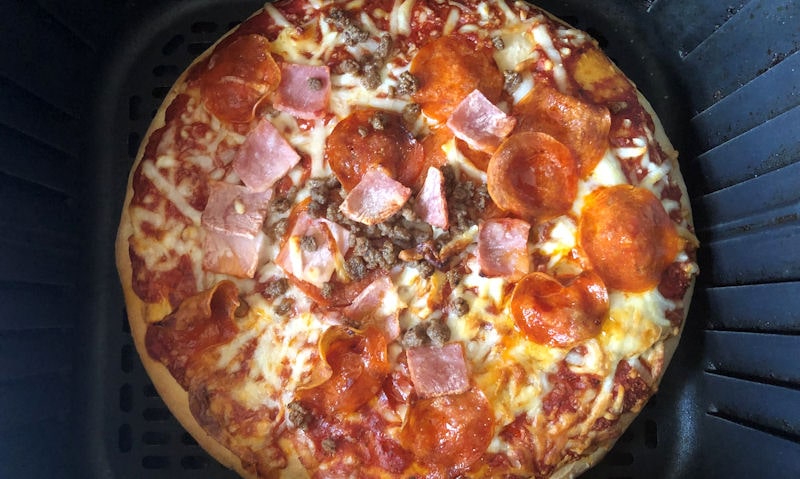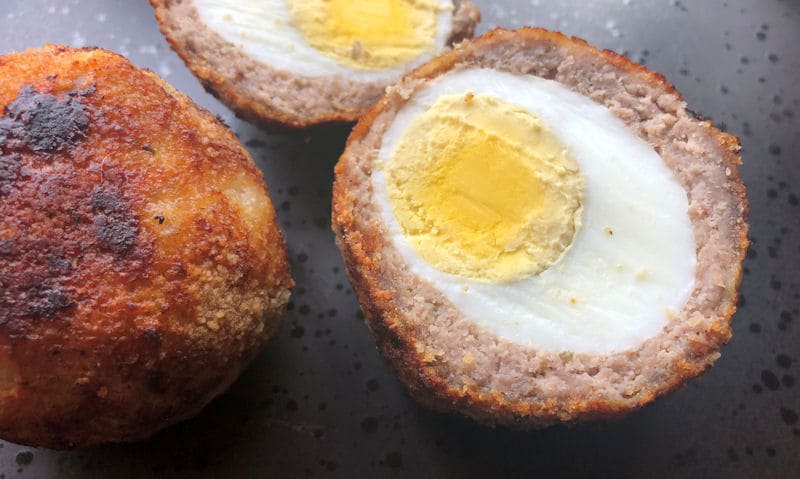
Scotch Egg air fryer recipe
Great tasting Scotch Eggs can be air fried just as well, with the recipe consisting of sausages formed into balls, along with two medium eggs and white breadcrumbs.
Scotch Egg recipe involves shaping three sausages into two pork balls, which are wrapped around hard boiled eggs. Dredging process looks like this: coat in flour; coat in beaten egg; cover in breadcrumbs - and thoroughly spray Scotch Egg breadcrumbs in oil. Air fry at 355°F/180°C for 20 minutes.
CONTENTS:
What better way to make a traditional Scotch Egg than in an air fryer, which is both quick and easy, with no deep fat fryer in sight, and less fat and calories.
This air fryer Scotch Egg recipe has all the components used to make a classic Scotch Egg, and should render a robust savoury taste with a crispy breadcrumb bite. I will say, the look of air fried scotch eggs can vary - with mine looking baked with char - rather than a golden crispy crumb like you would expect, with the taste very similar all the same.
Eggs are preferably hard boiled in a saucepan of boiling water, where air frying boiled eggs is an option with no option to genuinely boil two hard eggs for 12 minutes.
Regular sausages are required which are divided into 1½ sausages, which are then mashed together before forming into two pork balls. Now you have two sausage patties which are pressed on clingfilm - which is needed to help wrap the sticky pork sausage meat around the hard boiled egg.
Dredging comes next where both pork meat-wrapped eggs are lightly coated in flour; next comes dunking balls in a beaten egg - whilst ending with coating the balls in breadcrumbs. Finally, the Scotch Eggs must be well sprayed in cooking oil - with not a single dry spot remaining - to prevent breadcrumbs burning.
Raw Scotch Eggs are cooked in a preheated air fryer which must be set to 355°F/180°C, with a full cooking time of 32 Minutes. Line your air fryer basket in parchment paper, which is used to prevent breadcrumbs sticking.
Whilst a little awkward when air frying what are essentially round balls in an air fryer, frequently opening/closing the drawer can cause the Scotch Eggs to roll.
Being a little heavy handed on the air fryer drawer can lead to the Scotch Egg breaking, and so its vitally important you go carefully.
I don't ever recall eating a hot scotch other than a homemade deep fried one, for the reason Scotch Eggs are a party snack which are served cold. Eating a homemade Scotch Egg at room temperature after making this recipe will be fine - although chilling your air fryer Scotch Eggs for several hours prior to consuming - will be a better idea.
Chilled Scotch Egg as oppose to a served hot Scotch Egg will have an enhanced flavour, where the combination of egg and pork can get lost when eaten super hot.
INGREDIENTS
INSTRUCTIONS
NUTRITIONAL DETAILS:
CALORIES: 912 FAT: 40.6g SALT: 3.89g CARBS: 74.2g PROTEIN: 40.8g FIBRE: 27.9g ENERGY: 3,771kJAbout the ingredients
No substitutes and changes with an air fried Scotch Egg, where all Ingredients used to make a classic Scotch Egg in a deep fat fryer, are used to make in an air fryer.
Pork Sausages
Sure enough, I used these same TESCO Finest Reduced Fat Pork Sausages to make my air fried Sausage Rolls, so I couldn't resist using them again. Whilst they're better options out their for sure, selecting high quality sausages are a must.
Regular sausages like this aren't at all easy to work with when forming into balls to flatten into patties. Flour can be used although shaping the balls with use of clingfilm is a must.
Medium Eggs
What can I say about the eggs I used other than I shamelessly used caged hen eggs, which should really be organic eggs at all times.
Medium eggs are a must because the one and a half sausage meat I used for each Scotch Egg, isn't enough to wrap around eggs which could be larger.
White Breadcrumbs
With all the breadcrumb varieties - which usually come in a cardboard tub - select the breadcrumb that look good to you, at a price you can afford.
I used TESCO White Breadcrumbs, weighing 175g, which of course can be used to bake, grill, and fry - and of course air fry which is what we're doing here. Breadcrumbs look like bread out of the tub, and will turn golden brown when cooked. Air fry breadcrumbs coated in oil, in an effort to stop the breadcrumbs burning and drying out.
Spray Cooking Oil
On this occasion I used Sunflower Oil which just happens to be what was available in the cupboard, with any spray oil suitable for this Scotch Egg recipe.
What spray oil did I use exactly? Its called VitaDor Sunflower Oil, Light Cooking Spray, with just 1 calorie per spray.
Serving Suggestions
Scotch Eggs aren't normally something you would serve something with, so are more of a snack and/or appetiser which also applies to mini savoury eggs.
Most people will want to dunk their Scotch Egg in either tomato ketchup, HP Brown Sauce, and occasionally Mayonnaise. BBQ sauce and Mustard is also an option, and so is mayonnaise varieties, like Piri Piri and Garlic Mayonnaise.
Additional options can include your favourite relishes and chutneys.
I like to eat all kinds of breaded meat - with pork and chicken especially - with Mac N' Cheese, where a small serving with a Scotch Egg should compliment each other well. With that, this must be on the rare occasion the freshly made Scotch Egg is served hot.
Recipe PROS & CONS
Scotch Egg recipes made in an air fryer do have there drawbacks, but also there's benefits in terms of health, so let's take a look at the pros and cons.
PROS:
Huge benefit to air frying Scotch Eggs of course, is that you save on fat and calories, with less than 4 calories needed to coat the Scotch Eggs in spray oil. Scotch Eggs are usually deep fried, and thus you avoid the unnecessary fat.
Whether the Scotch Eggs are air fried or deep fried, the taste and texture is expected to be near identical, with little difference between the two.
CONS:
Downsides to making Scotch Eggs in an air fryer is few and far between, with the big one being uncoated breadcrumbs leading to burning. Breadcrumbs must be properly coated in oil, which should replicate deep fat frying.
With Scotch Eggs being essentially balls, it would be hard to keep them stable in the air fryer as you frequently open and close the drawer to turn, spray and check on them. When the balls roll, this could lead to the balls forming into an odd shape - where the pork balls can also break if being too heavy handed.
In Pictures: How to make Scotch Eggs in air fryer
No better way than understanding the instructions for this twenty step Scotch Egg air fryer recipe, where these picture directions should answer your concerns.
STEP 1: Boil 2 eggs on Medium Heat for 12 minutes
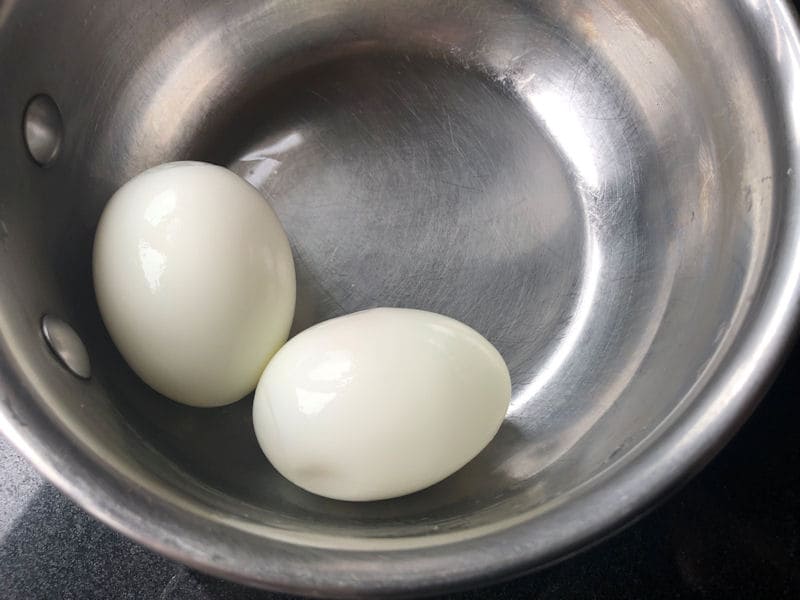
Boil two eggs to a soft centre by bringing the water up to boil, before gently popping eggs into the water. Allow to boil for 12 minutes to be on the safe side. Stop eggs cooking any longer by sitting boiled eggs in a pan of cold water for several minutes.
STEP 2: Add about 100g of Flour to bowl
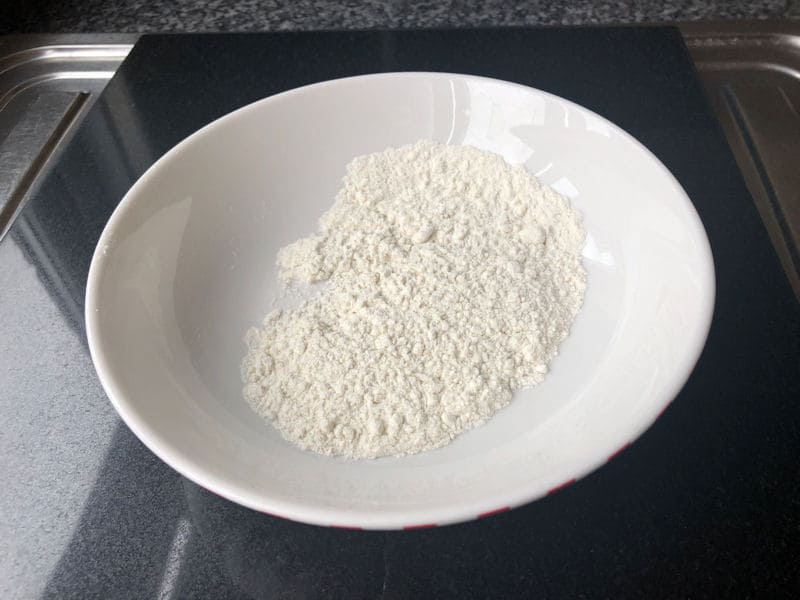
Begin to setup your dredging process by first adding as much as 100g of all purpose flour to a suitably size bowl/dish.
STEP 3: Whisk single egg into bowl
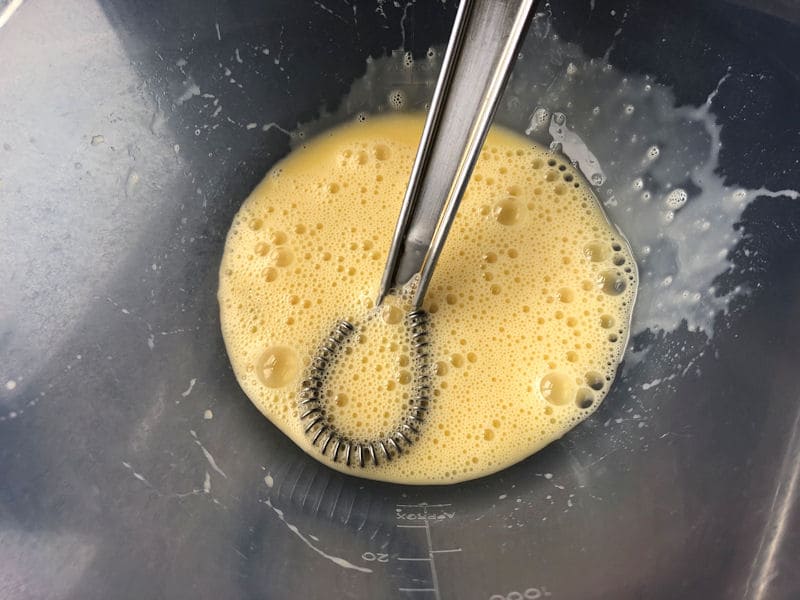
Crack a single egg into a second bowl which will be used to coat the raw sausage meat in. One egg is more than enough so don't be tempted crack in another.
STEP 4: Pour 70g of breadcrumbs in third bowl
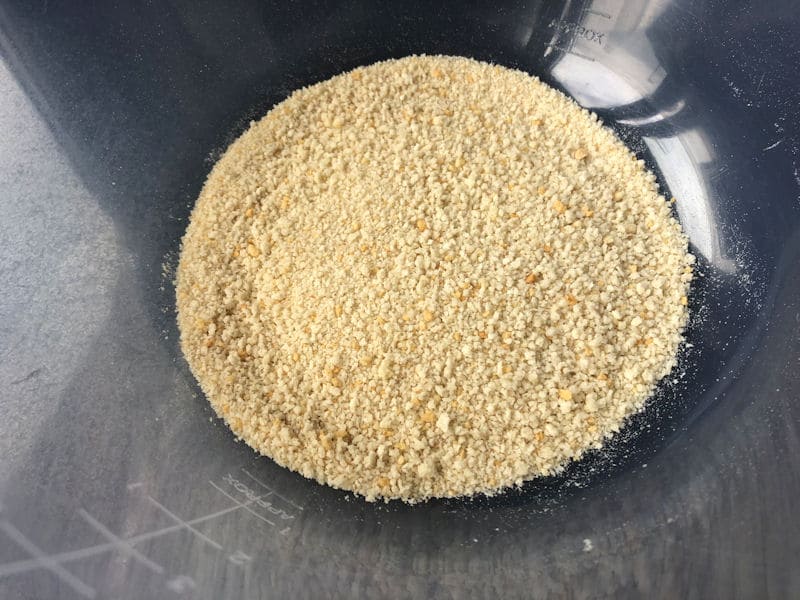
Empty about 70g of white breadcrumbs into a third bowl this time, which was a third of the breadcrumbs out of the tub it was in. Shake the bowl until the breadcrumbs are evenly spread across the bottom of the bowl.
STEP 5: Locate empty fourth bowl next to other three
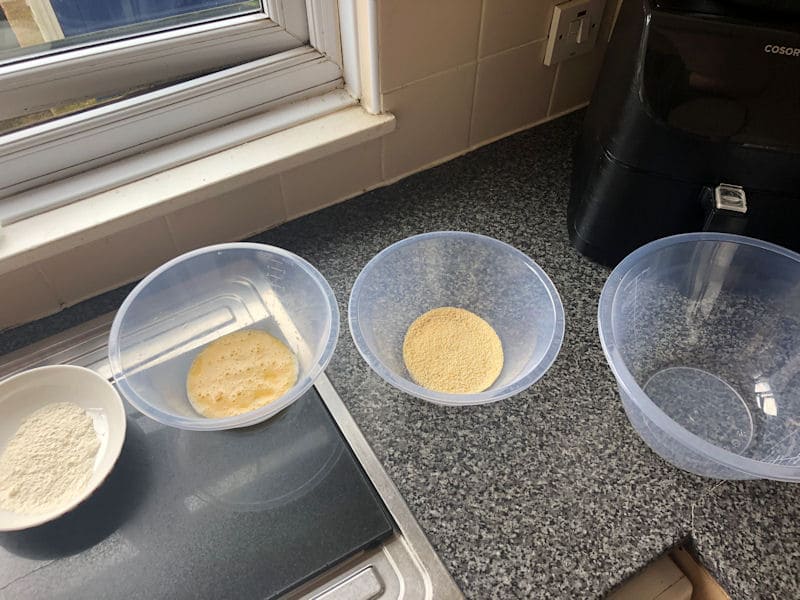
Four bowls - one ceramic, three plastic - positioned in a row across the kitchen counter, where the dredging process will call for covering in flour; coat raw Scotch Eggs in a beaten egg; ensure balls a covered well in breadcrumbs; coat all sides of balls in oil, whilst using this fourth bowl as a way to contain the oily mist of the spray.
STEP 6: Peel casing off all 3 sausages; cut one sausage in half
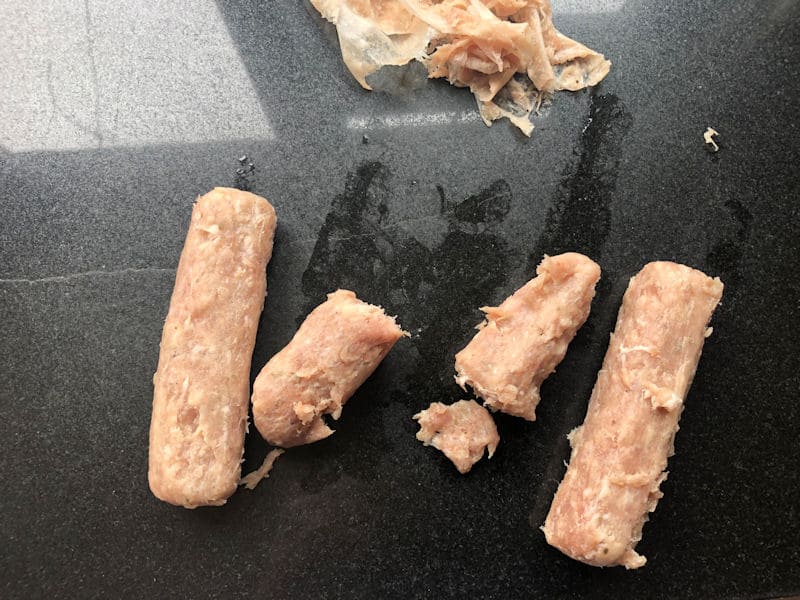
Cut off the casing of three pork sausages with a pair of scissors, ensuring no casing remains before forming one and a half sausage into a single pork ball - where you'll be making two balls for the purpose of this recipe.
STEP 7: Combine 1½ sausages to form ball
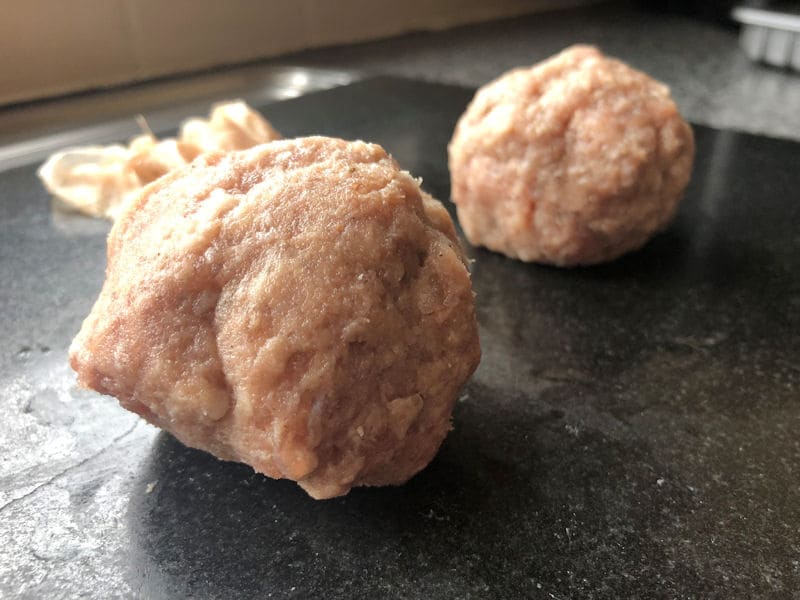
Pork balls you created with three raw sausages can be formed into balls by hand - whilst a perfect ball can be made - yet pork balls don't have to be perfectly round, due to them being flattened out into sausage patties in a moment.
STEP 8: Flatten pork balls to a 5mm thickness on clingfilm
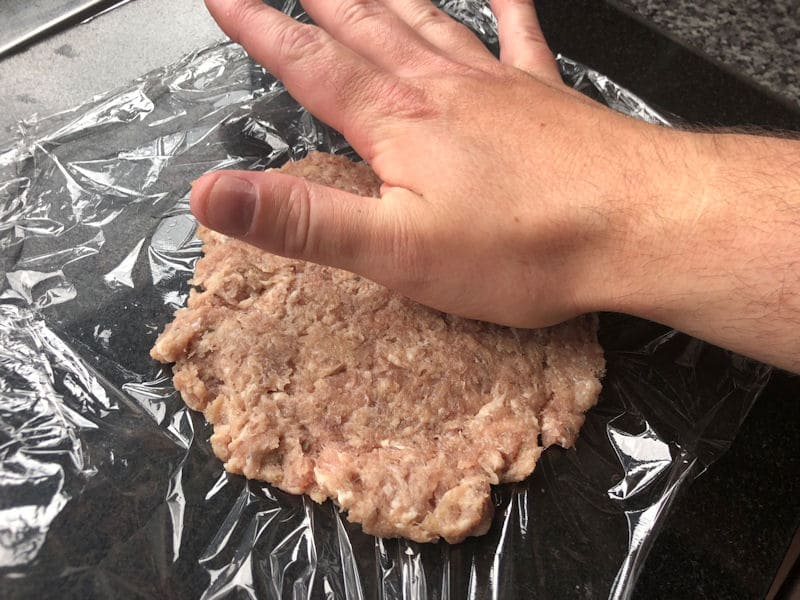
Press down each pork ball into a 5mm thick - and about 130-140mm wide - sausage patties, which will feel a little sticky and not at all pliable. Be patient flattening each meat ball into shape - where I like to avoid use of additional flour. Wrapping each raw Scotch Egg in foil will come next, thus its vitally important this process is done on clingfilm.
STEP 9: Centre a cold boiled egg on each patty
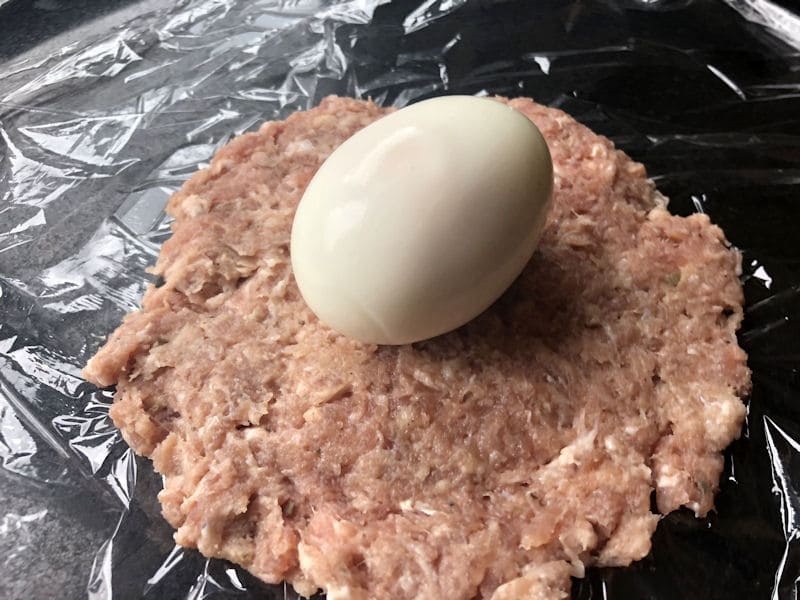
Sit one boil egg in the centre of your flattened sausage patty, whilst ensuring you don't apply pressure to the egg, which will thin out the pork meat underneath.
STEP 10: Use clingfilm to wrap pork meat around boiled eggs
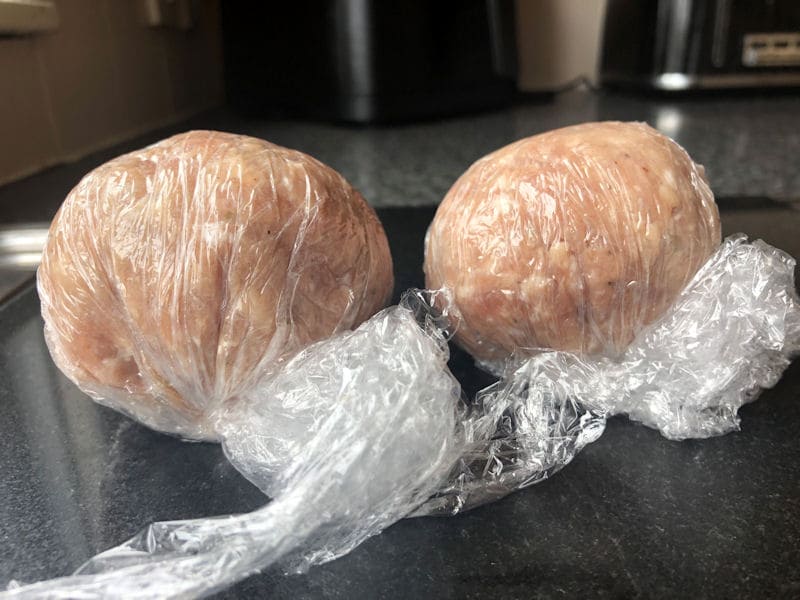
Bring up all sides of the clingfilm up and around the boiled egg, where you will fold the clingfilm as you attempt to wrap the sausage meat over the eggs. Once you do, use the clingfilm to form a ball. Unfortunately, it is expected the balls will lose their shape before and whilst air frying.
STEP 11: Place Scotch Egg Balls in dish to coat in flour
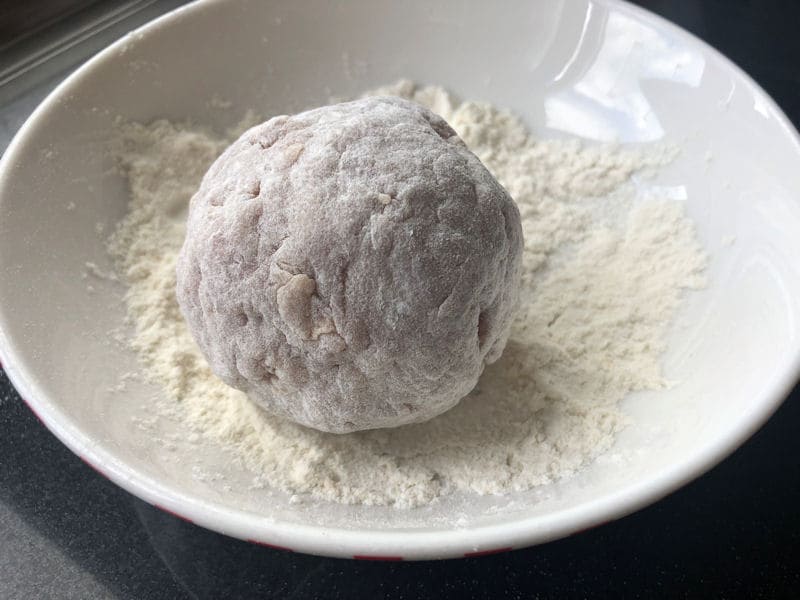
To apply a beaten egg to the sausage meat, you must first coat the sausage meat in flour, which acts as a binder. Coat in flour but do blow off or tap away excess flour.
STEP 12: Dunk individual raw Scotch Eggs in whisked egg bowl
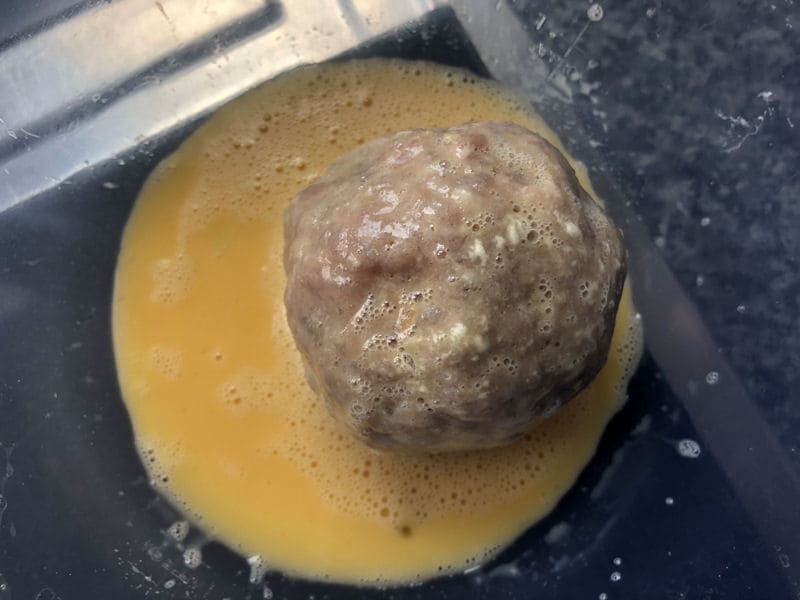
Gently pop your flour-coated raw Scotch Eggs in a beaten egg in one of your four bowls. Roll the pork ball over to coat fully in beaten egg with one hand, so you can repeat the process again with a spare dry hand.
STEP 13: Pop egg-coated Pork Ball in breadcrumb bowl
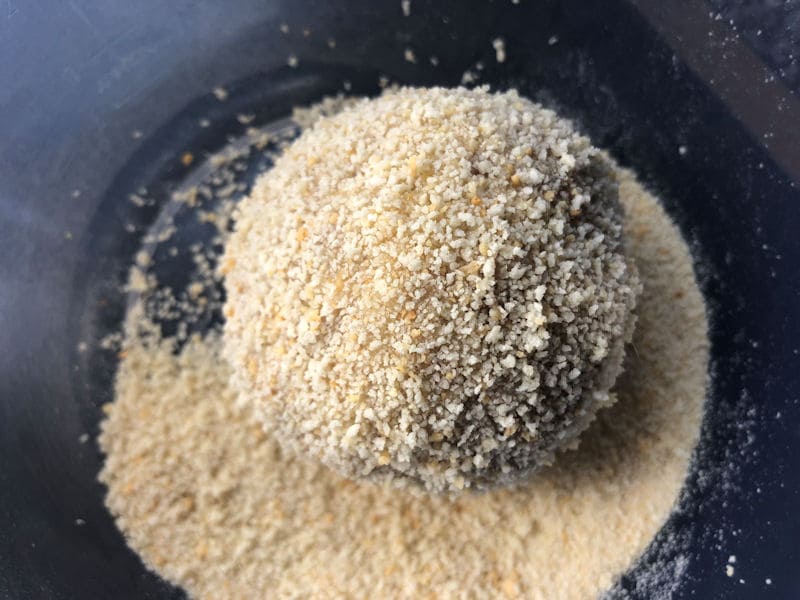
Satisfying as its looks, once you place your egg-soaked raw Scotch Eggs in the bowl of white breadcrumbs, the Scotch Eggs will not only begin to look like the real thing - but it will now be far easier, and cleaner, to handle the breadcrumb-coated Scotch Eggs.
STEP 14: COAT Scotch Egg breadcrumbs in oil
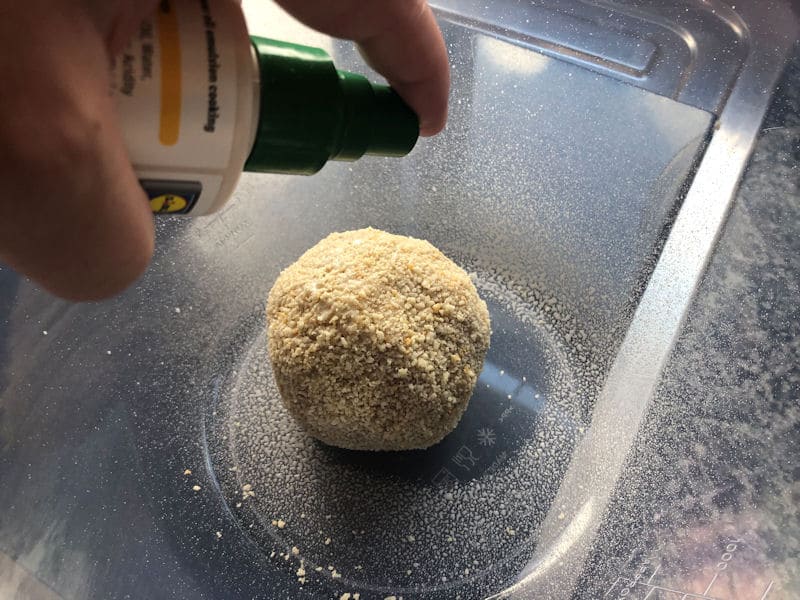
Can't risk breadcrumbs burning which is why I feel its a good idea to coat breadcrumbs in a few sprays of oil, which is Sunflower oil on this occasion, but that isn't important. Coating breadcrumbs in oil takes place in a bowl, which helps to contain the oil.
STEP 15: Preheat air fryer for 5 Minutes
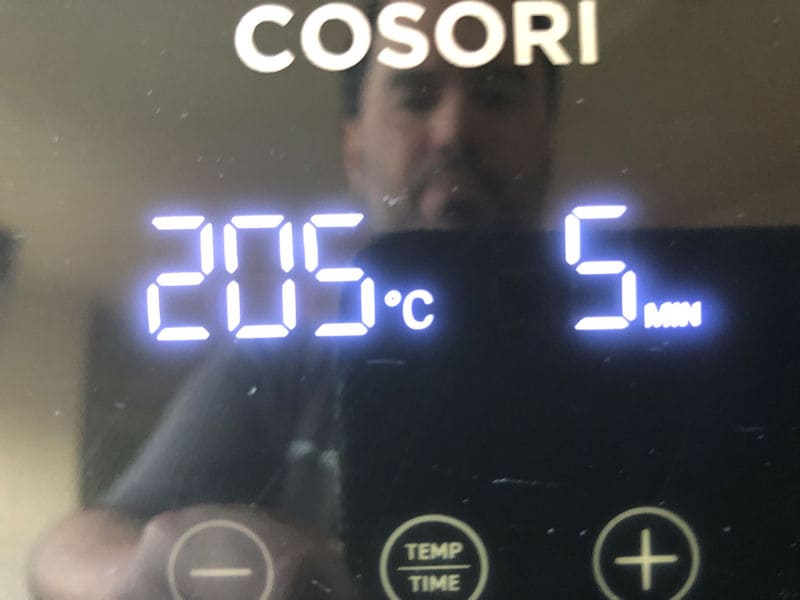
Dial in time stated or why not use your PREHEAT function on your air fryer to set the air fryer to what will probably be a temperature of 400°F/205°C, for 5 Minutes minimum.
STEP 16: Line air fryer basket with Parchment Paper
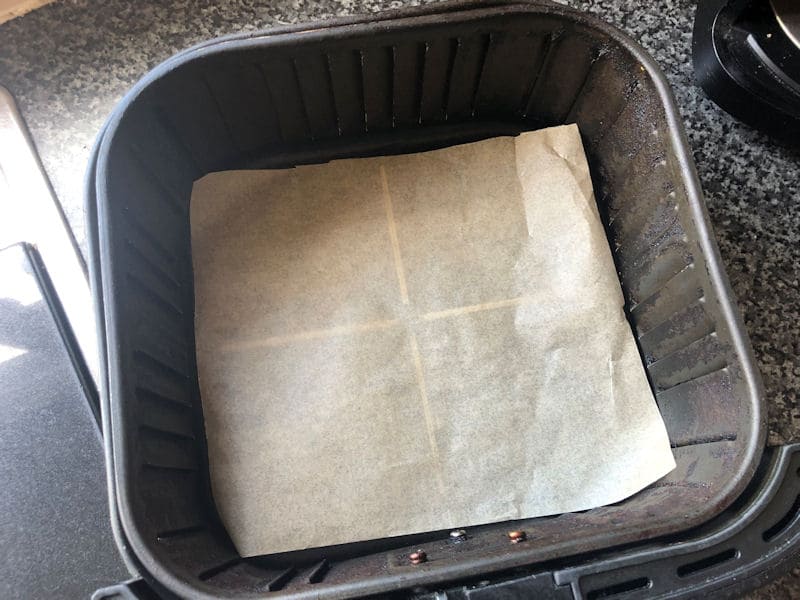
Air frying breadcrumb-coated Scotch Eggs would expect a little sticking, which I why parchment paper is used to prevent breadcrumbs adhering all together.
STEP 17: Position raw Scotch Eggs on lining
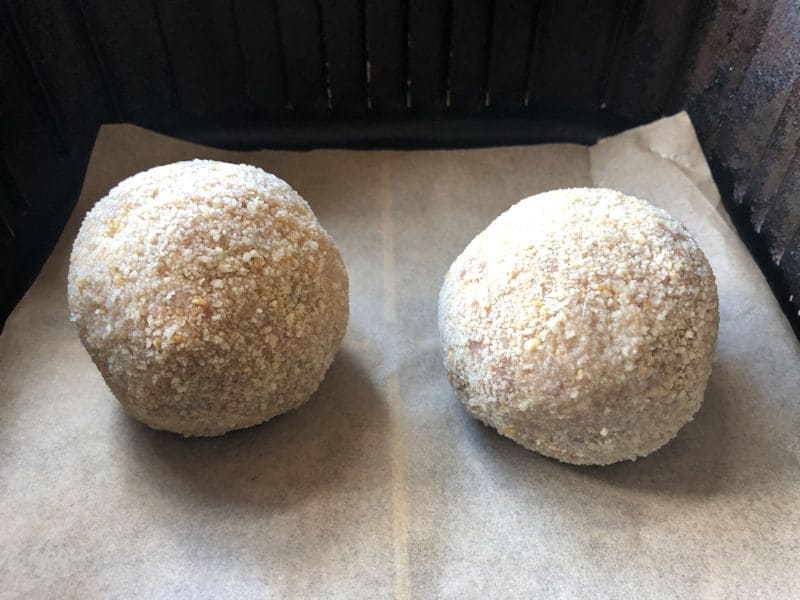
With your hands, place the two raw Scotch Eggs on top of the baking paper-lining, whilst being extra careful not to roll the balls as you close the air fryer drawer.
STEP 18: Set temp: 355°F / 180°C; time: 32 Minutes
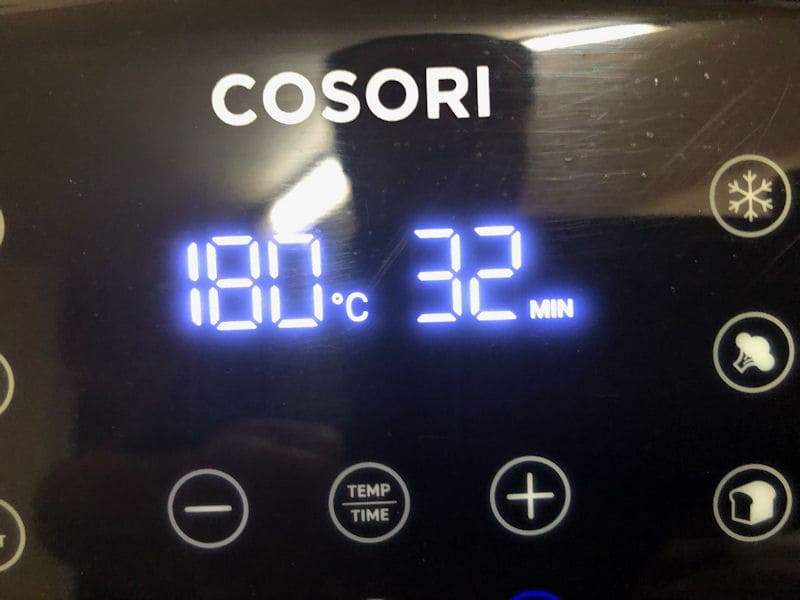
Set time and temperature as stated, with a chance the Scotch Eggs could fully cook within 20 minutes. If the breadcrumbs look a bit pale towards the end, there's certainly no harm in adding additional minutes, until go golden and crispy.
STEP 19: Frequently turn Scotch Eggs; spray in extra oil
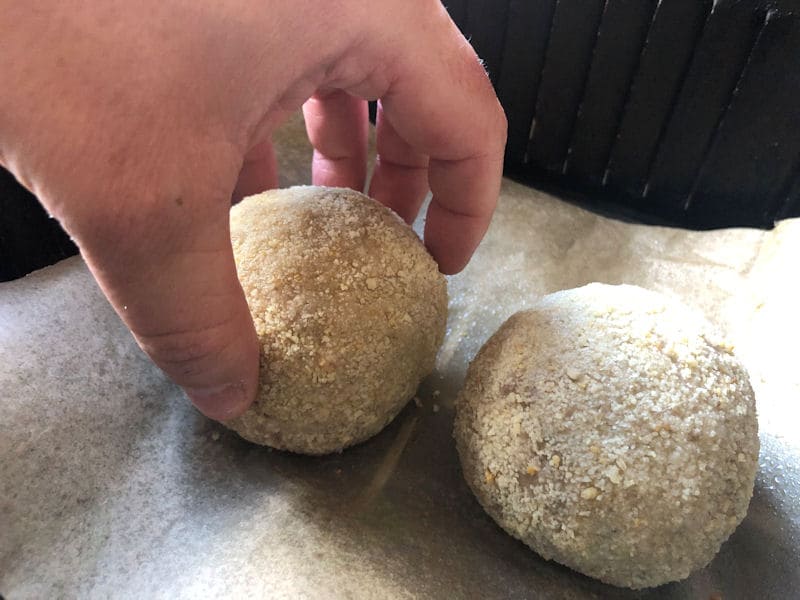
Begin to turn over the Scotch Eggs on the 5 minute mark, then continue to turn/roll the eggs in all directions, every 3-4 minutes thereafter. So you know, it can be difficult to roll the eggs over to keep in place - so try your best to frequently turn over.
STEP 20: Take Scotch Eggs out of air fryer
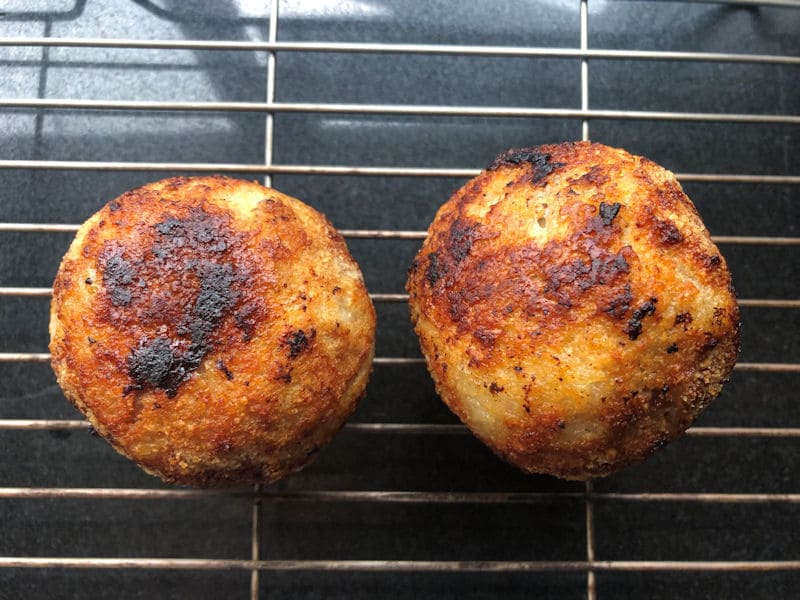
Pull your fully cooked air fried Scotch Eggs out of your air fryer with use of paper towel or a large spoon. Allow to cool on a rack to prevent condensation making the Scotch Eggs soggy on the bottom. Serve warm with an option to chill in the fridge for later.
